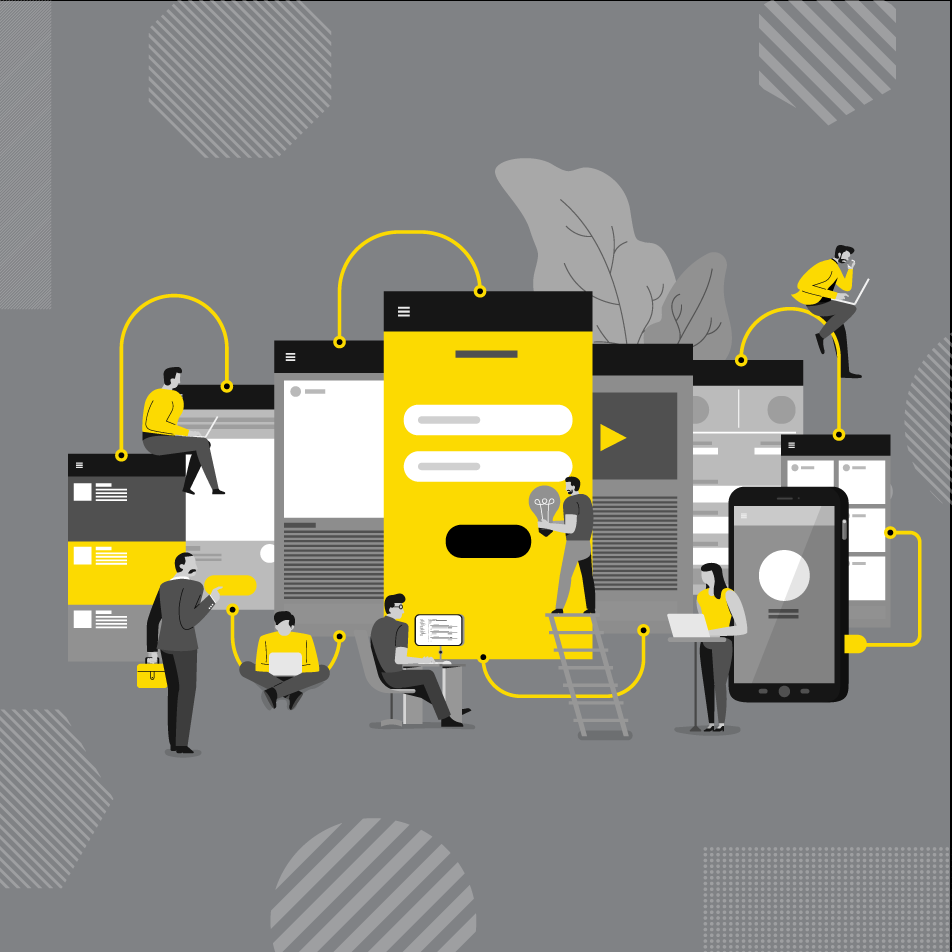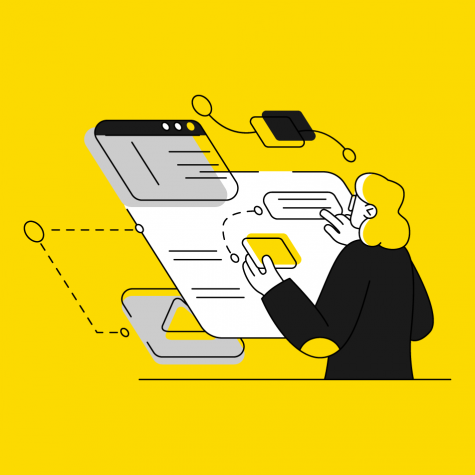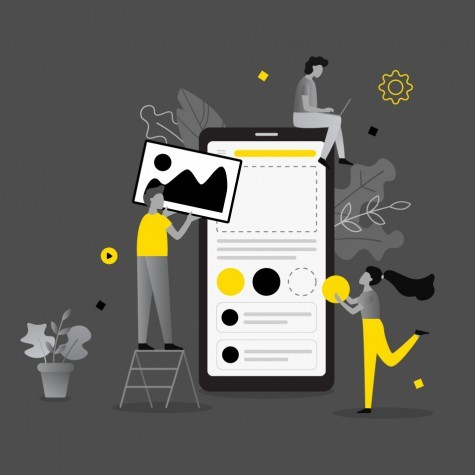We grow by sharing our experience, knowledge and expertise/

The 2021 UX train is coming and this year it probably won’t pass you by
It’s 2021. Are you freaking out about your UX yet?
Probably not.
And, for once in maybe the last five years, you get a well-earned pass.
2020 was so destabilizing in so many ways that anything—brand, website or child—that survived in its wake is really just looking for solid ground to stand on, not a full-fledged, guns-blazing design revolution.
If we can speak for our fellow brand experience designers and UX-savvy business owners everywhere: in some sense, we’re all just feeling glad the web is still there and working.
Which, we’d like to point out, has its upside.
For one, it isn’t 2016. We aren’t about to be deluged by a flood of design and tech innovation that will make us all feel like running out and rebranding just to keep our heads above water.
With so much UX wonderfulness already in the pipeline—and so much social upheaval around us—UX design in the aftermath of 2020 will be quieter and, dare we say, more introspective.
Plus, there was so much happening in the past five years that many of us simply didn’t have time to explore everything we wanted to.
All of this makes 2021 a great chance to revisit your past UX to-do lists and check off what still matters to you—whether you’re leading your own marketing team or looking for some outside help to make sense of it all.
At the same time, new years are always good for one thing: fresh, new beginnings.
Apropos of that, here’s a list of the UX trends—some tried and tested, some fresh off the block—we’re keeping an eye on as we head into a hopefully more subdued year of business as usual.
Voice user interface and voice commands
The voice user interface (VUI) revolution has been on for a while now, but how many brand experiences outside of Google Assistant or Amazon’s Alexa have you actually interacted with?
VUI is like the sleeping giant that hasn’t fully woken yet. When it does, watch out.
There’s just so much potential here. So much that according to Adobe, 91% of the brands they interviewed back in 2019 had already invested in voice. Another 75% felt it improved user journey.
Take a simple newsletter sign up form. How much easier would it be for your visitors to subscribe just by telling you? Think about it. With a VUI audio prompt, you could ditch those annoying pop-ups everyone hates and you’d never have to worry about losing potential subscribers just because they couldn’t find your form.
Or imagine if the first thing your website did—after a quick, gorgeous intro to your brand—was ask users what they wanted and connect them with the information they were looking for, instead of bombarding them with menu choices they never asked for?
Imagine if that conversation happened in your brand voice and sounded just like the user segment you wanted to reach?
That, folks, is the ultimate customer-centric digital experience.
Reaching for your mouse already?
Lucky for you, the train hasn’t left the station. VUI is still, five years after it popped onto our radar, cutting-edge. You have time to catch up. And you can get started pretty easily with super clean, freemium VUI platforms like Fabble and Bot Society.
If you are going to take the plunge and make voice a part of your brand experience(s) and you’re still attached to your visuals, don’t worry. Adding VUI to your websites and apps doesn’t mean you have to go “screenless”. Smartphones, which give a hybrid audio-visual experience, are still the reigning champs of audio interactions, not smart speakers.
Virtual and augmented reality
Remember Google’s Project Glass?
It’s absolutely crazy to think that this was nine whole years ago. What’s even crazier is that the tragicomic push notification blizzard all the parody videos were poking fun at is—unbelievably—our daily reality in 2021.
Just not a reality we “wear” on our eyeballs. Yet.
But Google definitely knew what was coming. Because by 2025, projections say the VR/AR industry will be worth roughly €25 billion. If anything, the pandemic will be speeding that timeline up, and raising the stakes. When COVID-19 eventually recedes, the tide of remote-first tech it brought will be here to stay.
What does this mean for you, CMO? UX-minded business owner? If you or your clients are in gaming, healthcare, engineering, real estate, live events, video entertainment or retail, VR is going to be huge.
IKEA has already launched (back in 2017!) a VR app called IKEA Place to help shoppers design their living spaces from home. Virtual fitting rooms are here, and shoppers really like them. And the LiDAR technology that powers self-driving cars is now helping retail outfits get smarter by tracking physical purchasing routes to complement customer data maps. That’s just retail.
Okay, you’re not IKEA, and you may not have anything for customers to try on. But that’s not really the point. Customers (and users) everywhere are getting used to richer, interactive digital experiences. Soon they’ll come to expect them.
And don’t make the mistake of thinking it’s just for the sake of trying something new.
VR/AR actually helps people simplify and speed up their digital interactions. Which, as we’ve said before, should be the goal of any customer-centric digital experience you design.
If you haven’t started thinking in this direction yet, the good money says now is the time.
Mobile-first design
It feels odd to be bringing this up in 2021. Odd, but not unreasonable.
Because despite the fact that our user traffic pies have been mercilessly gobbled up by mobile since 2011, and despite the fact that Google switched to mobile-first indexing back in 2019, we still find plenty of desktop hold-outs who just love the look of a shrink-to-fit desktop screen on Gorilla glass or the feel of using your fingers like tweezers to zoom in on a restaurant menu that takes half a minute to load.
If you’re one of them, let’s just say there’s no better year to go mobile.
Don’t take our word for it either. Here are some stats that speak louder than snark. (If we sound a little like David Attenborough’s global warming witness statement, sorry, but we know how important this is for you to hear!)
Fact 1: Mobile web traffic has doubled since 2016.
Fact 2: In 2020, almost 54% of all internet traffic was mobile.
Fact 3: Over 90% of Facebook users access the data-gobbling giant with their phones, (and have been since 2017.)
Oy papi!
Yes, you say, but does this really have an impact on my bottom line?
To which we answer with another question: Did that iceberg have any impact on the Titanic? According to director James Cameron, who explored the wreckage definitively in 1998, yes, it sure did.
We won’t make this any more painful than it needs to be.
If you’re still partial to the panoramic view of your company your iMac gives you, your customers and clients aren’t. They’re looking for you on their phones (many of which are slower than you think). If they can’t find you in three seconds flat, they may not find you at all.
Microcopy
Now that we’ve gotten that mobile spanking out of the way, let’s have a chat about the elephant that we hardly ever let into the room: our microcopy.
One of the side benefits of all the attention UX is getting lately is that the conversation has finally opened up to the verbal component of our brand experiences. Words are hot. Words are sexy. Even the sweet smalltalk our brands makes on sign-up forms, thank you screens and call-to-action buttons.
Words are also what sort of distinguishes man from ape, so if you haven’t given much thought to how your brand sounds everywhere, listen to this ghost of UX future and consider a brand copy audit for 2021: print, web and everything in between.
Just like in human conversations, on the web not every click we make is going to be driving home a value proposition or hawking our services, products or missions. If that was the case, we’d all sound like the awkward dude at the party who only talks about his job.
A lot of what we are online is the words in between the messages. Quirky, reassuring error copy. A CTA that doesn’t feel like a CTA, or a sign-up form that takes our minds off the digital contract we’re about to commit to.
Like the Barcelona-based form gurus at Typeform realized back in 2015, forms, by themselves, suck. But if you turn them into conversations, oh, how fun they can be.
The conversation can extend to your 404 error page, which can even be an extension of your brand, or just there for a giggle. (Never underestimate the power of a little fun.)
Your voice can come through when you’re welcoming users back to your login page. (If you clicked on the link, click again. You’ll see different microcopy.)
And it can come through in the placeholder microcopy on your search bar, which at least 15% of your users prefer to an old-fashioned, brand-centric menu anyway.
Your digital presence is made up of thousands of moving parts. What binds it all together is the conversation you open up with your audience. Thoughtful, one-of-a-kind microcopy is your icebreaker, awkward silence filler and long-haul pen pal all rolled into one.
New directions in design
A five-part UX trends list wouldn’t be complete without some design predictions. Our designers delivered their envelopes just last night, kind of like at the Oscars. We never even peeked, not once.
And the winners are...
Dark mode is a solid contender for UX “should haves” heading into 2021. It’s good for the eyes, gives users agency, extends battery life (remember, half your users are on their mobiles), and it can be pretty visually stunning. Slack, Spotify, Instagram, Reddit, Twitch, and most Google Workspace apps, are just a few of your favorite apps that now offer dark themes. If you’re heading into a website revamp, or are designing an app in 2021, definitely consider dark mode.
Layers, 3D effects and floating elements are here. Hallelujah—if you’ve had enough of those super happy flat illustrated people that look like they were way too pretty and thin for Minecraft and all got jobs on SaaS websites. Hallelujah, too, if you’re sick of elegant geometric design, straight stock photography, hero banner videos and a host of other design trends that will be looking “so 2016” as we dive deeper into the funky eclecticism of 2021. In short, our design gurus predict that the near future will be looking a lot like Body Restore: clean, gorgeous, playful, bold.
Honorable mentions
Wild abstract elements
We got bored with static geometric design elements all by themselves by 2019. So designers have started to weird them up. They realized if you added motion, bolder palettes, crazier designs, and maybe a photograph or neumorphic element (see below)—voilá!—you’d have something recognizable but that you’d wait at least a date or two before bringing home to mother.
Scrolling transformations
We love stories that unfold as you scroll. They’re just impossible not to engage with and are naturally narrative. So, if you have just one “must have” on your website revamp list, our designers advise you to put scrolling transformations down. If you’re still not convinced, head on over to the open source, JavaScript animation library at Green Sock. You’ll leave a convert.
Neumorphism
Hard to say if we like this or it scares the bejeezus out of us. Tactile, popping, drop-shadowed buttons and objects that look real but not real at the same time? We’re reserving judgment until 2022. Safe to say, this rebellious lovechild of skeuomorphism and a Teletubby may take a while to fully catch on.
Big type
Serifs are back and proud. But sans serifs never really left. Huge sans serifs like 80s hair, but way cooler. The point is: type can make a statement all by itself. If you use it that way, you’re good for 2021.
3D immersive storytelling
The jury is still out on 3D, and who knows what will survive the test of time, but there is something jaw-droppingly fresh about these immersive, kinetic, CPU-hogging and gaudy visual statements in 2021.
Putting it all together
Wondering what it would look like if you poured all these design trends onto a single canvas? You might get something like this.
Take-away
It’s 2021 and you’re still online. You’re pushing forward with new ideas, for reaching your audience and helping your clients reach theirs.
When we say, “way to go”, we mean it. 2020 was a universal bummer, even if in the long run, the challenges it brought will end up speeding up our digital transformations and spurring on our creative thinking, UX included.
Not that there wasn’t plenty of that already. 2016-2020 saw a dizzying tide of UX innovation, both backend and frontend. The innovation has been game-changing, sometimes so much so that we haven’t even been able to keep up.
If you do anything in 2021, first take a deep breath.
Then revisit your UX to-do lists of years past. Some of the ideas we’ve talked about that were only in the reach of digital behemoths like Google and Amazon in 2017— ideas like VUI and VR/AR—will become standard in the next few years. Simply because customers like them.
Others—some design picks especially—are only passing trends.
We realize that knowing which is which, and how to get the best results for your UX budget, can be immensely overwhelming.
If you’d like some help planning your next digital move, that’s our job.




